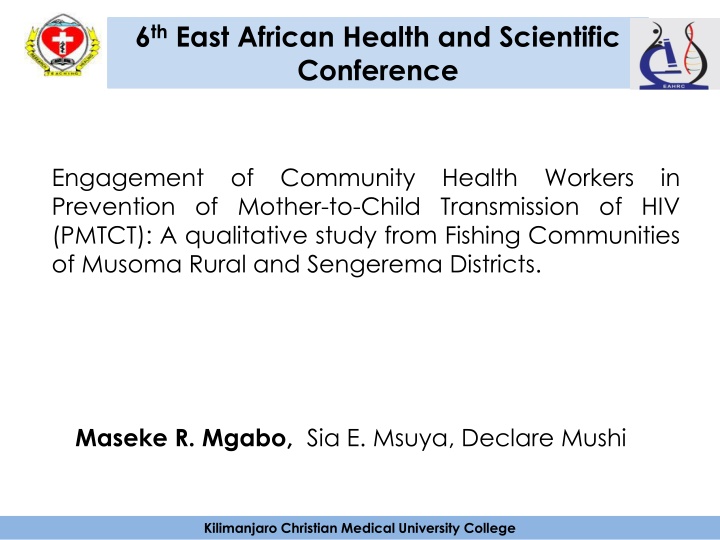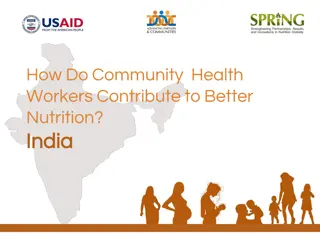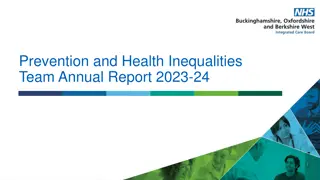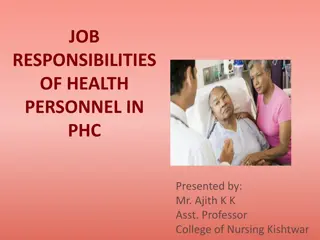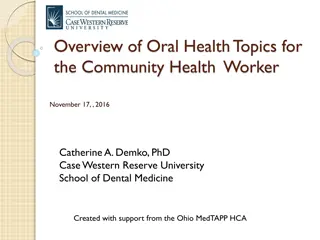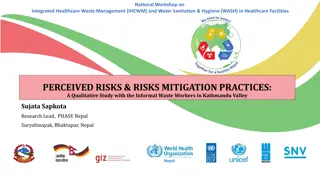Engagement of Community Health Workers in Prevention of Mother-to-Child Transmission of HIV in Fishing Communities
This study explores the involvement of Community Health Workers (CHWs) in addressing the challenges of Preventing Mother-to-Child Transmission of HIV (PMTCT) in fishing communities along the Lake Victoria shores in Tanzania. The research gap and study objectives focus on enhancing PMTCT programs by leveraging CHWs to bridge healthcare gaps and improve access to essential services in these high-prevalence areas.
Uploaded on Feb 28, 2025 | 3 Views
Download Presentation

Please find below an Image/Link to download the presentation.
The content on the website is provided AS IS for your information and personal use only. It may not be sold, licensed, or shared on other websites without obtaining consent from the author.If you encounter any issues during the download, it is possible that the publisher has removed the file from their server.
You are allowed to download the files provided on this website for personal or commercial use, subject to the condition that they are used lawfully. All files are the property of their respective owners.
The content on the website is provided AS IS for your information and personal use only. It may not be sold, licensed, or shared on other websites without obtaining consent from the author.
E N D
Presentation Transcript
6th East African Health and Scientific Conference Engagement of Community Health Workers in Prevention of Mother-to-Child Transmission of HIV (PMTCT): A qualitative study from Fishing Communities of Musoma Rural and Sengerema Districts. Maseke R. Mgabo, Sia E. Msuya, Declare Mushi Kilimanjaro Christian Medical University College
Background The first HIV case was from fishing community in Uganda. 73% of HIV-positive pregnant women received ARVs (prophylaxis or ART) for PMTCT of HIV and 55% received ART for their own health. To date HIV prevalence in fishing communities are very high globally than none fishing communities. HIV prevalence in in Uganda 7%vs 25% (Akullian et al., 2016) , Kenya 25.3% ( Hoshi et al 2016) , Tanzania no clear information Proportion of HIV-positive women receiving ART increased by 40% in 2014, compared to 2013. Coverage in provision of PMTCT services 99% In Tanzania general HIV prevalence is estimated at 5.1% among adults aged 15-49 year HIV prevalence among pregnant women in Tanzania is 5.6% Besides HIV/AIDS related services are inadequate in fishing community. Kilimanjaro Christian Medical University College
Background By the year 2013 HRH need was 145,454 for all cadre; whereas available health professions was 63,447, the shortage was 82,007, which was about 56%(MoHSW, 2014). CHWs have been very crucial in providing primary health care services (WHO, 2014; Bhutta et al., 2009; MoH-Rwanda, 2013). Among other factors engagement of CHWs has been targeting to bridge the gap of shortage of Human Resources for Health (HRH) at the same time, enabling to bring essential PHC services including PMTCT nearer to the community. It has been recommended that that integration of CHWs into the health care system if deployed at scale, might have a profound effect on achievement of MDGs 4, 5 and 6 (Kochi et al., 2014; Karfakis & Keehn, 2014; Lema et al., 2014). Kilimanjaro Christian Medical University College
Research Gap Information on engagement of CHWs in enhancing the implementation of PMTCT programme in fishing communities of Lake Victoria on Tanzanian side is limited Kilimanjaro Christian Medical University College
Study Objective Exploring the engagement of Community Health Workers (CHWs) in provision of Prevention of Mother to Child Transmission of HIV (PMTCT) among the fishing communities of Sengerema and Musoma Districts in Lake Zone of Tanzania. Kilimanjaro Christian Medical University College
Methods This was a cross sectional qualitative study, conducted in Musoma and Sengerema districts located in northern Tanzania, in Musoma and Mwanza regions respectively, along Lake Victoria shores. 25 health workers from 20 health facilities were involved Facilities in the proximity of less than 5 Km from the Lake shores Thematic analysis approach for data analysis Ethical clearance for this study was granted by the Kilimanjaro Christian Medical University College Research and Ethics Review Committee; Certificate No1008 Kilimanjaro Christian Medical University College
Results and Discussion CHWs were mainly involved in MNCH/ ANC and CTC services health care providers used CHWs as a coping strategy to curb the challenge of shortage of human resource in their facilities. The main roles played by these CHWs included supporting the health personnel in providing vaccination, vitamin A, deworming and mass drug administration and health promotion campaigns. Similar CHWs roles have been reported in South Africa (Ijumba, 2014),Tanzania (Feldhaus et al., 2015; Lema et al., 2014), and other developing countries (Lehmann & Sanders, 2007). Kilimanjaro Christian Medical University College
Results and Discussion While CHWs seem not to be optimally utilized in the implementation of PMTCT interventions in Sengerema and Musoma districts. In Malawi CHWs have been actively involved in; mobilizing and referring patients to HIV services including voluntary counseling and testing, ART initiation, prevention of mother-to-child transmission (PMTCT) and treatment of opportunistic and sexually transmitted infections (Mwai et al., 2013). In South Africa community care workers (CCWs) have been providing comprehensive package of TB/HIV/PMTCT prevention, case finding and treatment support services which has been a promising avenue to maximize the implementation of collaborative TB HIV PMTCT activities in Kwazulu Natal (Uwimana et al., 2012) Kilimanjaro Christian Medical University College
Results and Discussion As reported by the government, there is a general shortage of qualified staff at all levels, but the shortage is more evident at the lower levels and in the hardship working environment areas (URT, 2009). Tanzania has resorted into providing formal training and employing CHWs in a near future, (MoHSW, 2014; NACTE, 2016). However, working conditions and motivation challenges have been blamed leading civil servants turnover or and attrition in South Africa (Mampane, 2012) and Tanzania(Mrope & Bangi, 2014). Kilimanjaro Christian Medical University College
Results and Discussion Many LMIC put much less attention is given to improving the aspect of working environment that enhance intrinsic satisfaction and working climate for rural health workers necessary for job satisfaction and productivity( Jayasuriya et al 2012). Failure to cope with structural , socio-ecological (culture, norms, values, language barrier , motivation) (Busza et al., 2012; Hampanda, 2013) challenges might propel some of the CHWs either drop from work or to go for further studies since they have minimum qualification for further studies and eventually change into other professionals in future. Kilimanjaro Christian Medical University College
Results and Discussion Thus, when plan introducing trained CHWs into place, challenges leading to attrition should be taken into consideration. We should understand that providing formal training to CHWs will be providing the CHWs with a minimum education qualification qualifying the CHWs to pursue further studies which might lead them into changing to completely different cadre of professions Our primary aim of having trained CHWs might not be achieved. In this regard, we propose that getting the natives and imparting them with necessary knowledge and skills would be more sustainable and reliable and thus retaining the real meaning of CHWs Kilimanjaro Christian Medical University College
References Bhutta, Z.A., S, L.Z., George, P. & Luis, H. (2009). Global Experience of Community Health Workers for Delivery of Health Related Millennium Development Goals :A Systematic Review, Country Case Studies, and Recommendations for Integration into National Health Systems. Geneva. Feldhaus, I., Silverman, M., LeFevre, A.E., Mpembeni, R., Mosha, I., Chitama, D., Mohan, D., Chebet, J.J., Urassa, D., Kilewo, C., Plotkin, M., Besana, G., Semu, H., Baqui, A.H., Winch, P.J., Killewo, J. & George, A.S. (2015). Equally able, but unequally accepted: Gender differentials and experiences of community health volunteers promoting maternal, newborn, and child health in Morogoro Region, Tanzania. International journal for equity in health. 14. p.p. 70. Ijumba, P. (2014). Intervention for improved newborn feeding and survival where HIV is common Perceptions and effects of a community-based package for maternal and newborn care in a South African township. Uppsala University. Karfakis, E. & Keehn, J. (2014). Current Practices to Improve Uptake , Retention and Adherence for Option B + in Malawi. mothers2mothers Malawi. Lilongwe. Kochi, E., Fabian, C., Sapra, S. & Gandrup-Marino, K. (2014). Focus Structure Strategy UNICEF Innovation Annual Report 2014. Lema, I.A., Sando, D., Magesa, L., Machumi, L., Mungure, E., Sando, M.M., Geldsetzer, P., Foster, D., Kajoka, D., Naburi, H., Ekstr m, A.M., Spiegelman, D., Li, N., Chalamilla, G., Fawzi, W. & B rnighausen, T. (2014). Community Health Workers to Improve Antenatal Care and PMTCT Uptake in Dar es Salaam , Tanzania : A Quantitative Performance Evaluation. Journal of acquired immune deficiency syndromes. 67. p.pp. S195 S201. Mampane, P.M. (2012). the Teacher Turnover Crisis. Evidence From South Africa. Business Education & Accreditation. 4 (2). p.pp. 73 83. Mrope, G. & Bangi, Y.I. (2014). Examining the Influence of Management Practice and Attitudes on Employee Turnover : A Case of Kibaha District Council Abstract : The International Journal of Business & Management. 2 (9). p.pp. 11 18. Mwai, G., Mburu, G., Torpey, K., Frost, P., Ford, N. & Seeley, J. (2013). Role and outcomes of community health workers in HIV care in sub-Saharan Africa: a systematic review. Journal of the International AIDS Society. 16. p.pp. 1 14. NACTE (2016). Admission Guidebook for Health Training Institutions 2015/2016. Dar Es Salaam: The National Council for Techinacal Education. Uwimana, J., Zarowsky, C., Hausler, H. & Jackson, D. (2012). Training community care workers to provide comprehensive TB/HIV/PMTCT integrated care in KwaZulu-Natal: Lessons learnt. Tropical Medicine and International Health. 17 (4). p.pp. 488 496. Hoshi T, Fuji Y, Nzou SM, Tanigawa C, Kiche I, Mwau M, Mwangi AW, Karama M, Hirayama K, Goto K and Kaneko S (2016) Spatial distributions of HIV infection in an endemic area of Western Kenya: Guiding information for localized HIV control and prevention. PLoS ONE 11(2): 1 14 Akullian, A.N., Mukose, A., Levine, G.A. & Babigumira, J.B. (2016). People living with HIV travel farther to access healthcare: A population-based geographic analysis from rural Uganda. Journal of the International AIDS Society. 19 (1). p.pp. 1 8. Kilimanjaro Christian Medical University College
ACKNOWLEDGEMENT Kilimanjaro Christian Medical University College
